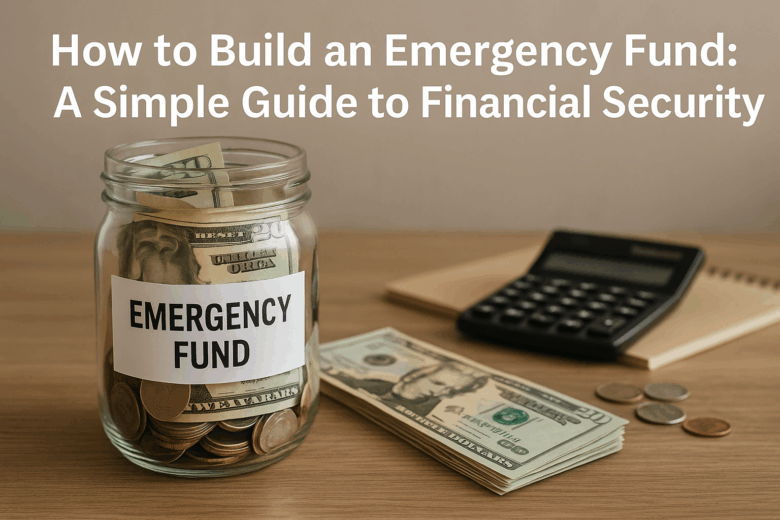Building an emergency fund is one of the smartest steps you can take toward achieving financial peace of mind. It acts as a safety net that protects you during unexpected life events—whether it’s a sudden job loss, a medical crisis, or an urgent home repair. Without this financial cushion, even minor disruptions can spiral into major setbacks.
This guide will walk you through everything you need to know about emergency funds: why you need one, how much to save, and how to build and maintain it in a practical, sustainable way.
Why an Emergency Fund Is Essential
Life doesn’t always go according to plan. No matter how carefully you manage your budget, unexpected situations can and will arise. Common examples include:
- Sudden unemployment
- Medical emergencies not fully covered by insurance
- Car breakdowns
- Urgent home repairs
- Emergency travel due to family illness
If you don’t have money set aside, these moments can lead to high-interest debt or financial hardship. Credit cards and personal loans may offer temporary relief, but they often lead to long-term financial burdens.
An emergency fund allows you to handle these situations calmly, without derailing your long-term financial goals. It gives you the freedom to make better decisions—whether it’s taking time to find the right job after a layoff or covering a large expense without stress.
How Much Should You Save in an Emergency Fund?
The ideal amount to keep in an emergency fund depends on your lifestyle, income stability, and responsibilities. Most financial experts recommend saving three to six months’ worth of essential living expenses.
What Counts as Essential Expenses?
When calculating your goal amount, consider only non-negotiable monthly expenses, such as:
- Rent or mortgage payments
- Utility bills (electricity, water, gas, internet)
- Food and groceries
- Health insurance or medical costs
- Transportation (car payments, fuel, public transport)
- Basic childcare or education expenses, if applicable
Who Should Save 3 Months of Expenses?
- Individuals with a secure, stable job
- Single adults without dependents
- People with minimal monthly expenses
Who Should Save 6 Months (or More)?
- Freelancers, contractors, or gig workers
- Households with children or other dependents
- People with variable or seasonal income
- Homeowners responsible for major repairs
Start by calculating your average monthly expenses. Multiply that by 3 to 6 to set your target emergency fund.
Example: If you spend $2,500 a month on essentials, aim for:
- $7,500 (3 months)
- $15,000 (6 months)
How to Start Building Your Emergency Fund
Even if the goal amount seems overwhelming, don’t worry. What matters most is getting started and being consistent. Here are the steps to help you begin:
1. Set a Specific, Achievable Goal
Knowing your target amount gives you a clear destination. Break it down into smaller milestones to make it feel more manageable.
Instead of focusing on saving $15,000, try focusing on the first $500, then $1,000, and so on. Celebrating small wins keeps you motivated.
2. Open a Separate Savings Account
Keep your emergency fund in a separate savings account to avoid spending it accidentally. Look for a high-yield savings account or an account that offers interest and is easily accessible—but not so easy that you’re tempted to dip into it for everyday expenses.
Avoid mixing your emergency fund with your checking account. The physical separation reinforces the idea that this money is off-limits unless there’s a real emergency.
3. Automate Your Contributions
Consistency is the key to success. Set up automatic transfers from your checking account to your emergency fund every time you receive a paycheck.
Start with a fixed amount—say, $100 every two weeks—and adjust as your income grows. Automation takes willpower out of the equation and builds momentum quietly over time.
4. Start Small if You Need To
Don’t get discouraged if you can only afford to save a little at first. Even $20 per week adds up over time. The important part is building the habit.
Once your income increases or you cut back on spending, you can bump up your contributions.
5. Cut Back on Non-Essential Spending
If you want to grow your emergency fund faster, review your budget for places to trim.
- Skip takeout meals and cook at home
- Cancel unused subscriptions
- Reduce entertainment or impulse shopping
- Limit luxury or convenience spending
Use the money you save to feed your emergency fund. Redirecting even small amounts can make a big difference over time.
How to Maintain Your Emergency Fund
Saving is just the first step. Protecting and replenishing your emergency fund is equally important.
Only Use It for True Emergencies
It’s tempting to dip into your fund for a vacation, a new phone, or a home upgrade, but resist the urge. Your emergency fund is for unforeseen, unavoidable events only.
If you’re unsure whether an expense qualifies, ask yourself:
- Is this urgent?
- Was it unexpected?
- Is it necessary for my well-being or basic functioning?
If the answer is yes to all three, it’s likely an appropriate use.
Replenish the Fund Quickly After Use
If you ever need to use your emergency fund, make it a priority to rebuild it as soon as possible.
Pause non-essential purchases or discretionary spending for a few weeks or months until you restore the full balance. Think of it as repaying a loan to your future self.
Review Your Emergency Fund Regularly
Your needs may change over time. Review your emergency fund once or twice a year—especially after major life events like:
- Changing jobs
- Getting married or divorced
- Having children
- Buying a home
- Moving to a new city
Recalculate your monthly expenses and adjust your savings goal accordingly.
Other Tips to Strengthen Your Safety Net
- Use windfalls wisely: Tax refunds, bonuses, or gifts are great opportunities to boost your emergency fund quickly.
- Keep it liquid: Your emergency fund should be accessible. Avoid locking it in long-term investments or accounts with penalties for withdrawals.
- Pair it with insurance: Emergency funds are a great buffer, but they work best alongside proper insurance coverage for health, home, car, and life.
Building Financial Confidence for the Future
An emergency fund won’t solve every financial problem, but it will give you the confidence and security to handle life’s surprises without panic or debt. It lays the groundwork for smarter decisions and long-term financial growth.
Once your emergency fund is in place, you can focus on other goals like investing, buying a home, or starting a business—without worrying about what could go wrong.
Final Thoughts: Start Small, Stay Consistent
Building an emergency fund is not a sprint. It’s a long-term commitment that pays off in peace of mind and stability. You don’t need to be perfect—you just need to get started.
Start with what you can, automate your savings, and keep your goal in mind. Every dollar saved is a step toward a more resilient and empowered financial future.
Remember: The best time to start building your emergency fund is today.




